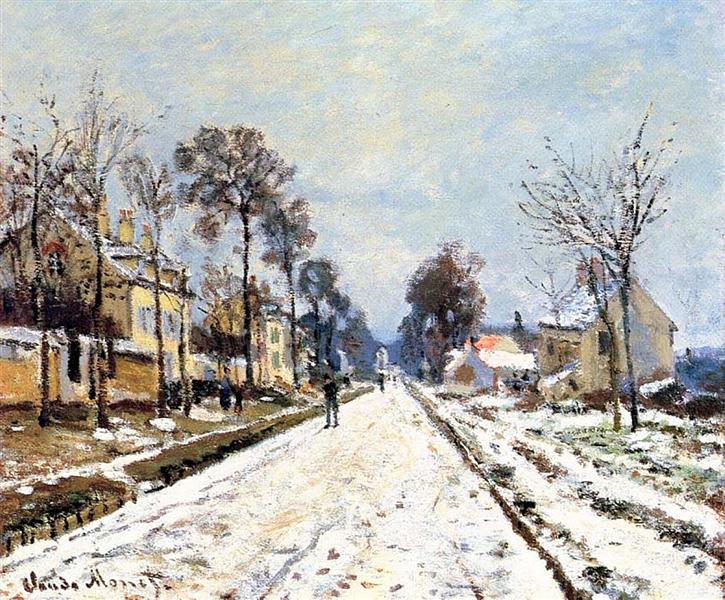Description
The work "Snow Effect - The Way to Louveciennes" by Claude Monet, created in 1870, stands out as an eloquent example of the incipient impressionist movement and the unique mastery of the artist to capture the light and color in winter landscapes. This painting is not only a testimony of the technical innovations of impressionism, but also offers a look at Monet's fascination by nature and its ability to evoke emotions through the representation of the winter scene.
The composition of the work is remarkable in its structure and atmosphere. Monet presents a path that is gently drawn through a snow -covered landscape, which is characterized by its almost abstract treatment of space. As an invitation, the road seems to lead the viewer to an indefinite distance, suggesting a physical and emotional trip. In the foreground, the snow, with its soft and bright texture, becomes a living canvas where the moments of light and shadow are intertwined, creating a vibrant compositional dance. Monet's choice of this perspective generates a connection between the observer and the very essence of winter.
The use of color in "snow effect" is another fundamental aspect that deserves attention. Monet uses a palette composed of vibrant white, blue and brown and green touches, which suggest the interactivity between light and snow. The variation in white shades is not limited to a single nuance; Instead, whites leave the canvas with different degrees of luminosity and depth, which suggests the complexity of the light reflected on the snowy surface. This attention to color and light is a defining characteristic of Monet's work, and in this work it seems to be doing a visual meditation on the ephemeral nature of the moment.
Regarding the presence of human or animal figures, this painting is mostly presented as an inanimate landscape, in which the loneliness of the winter path suggests a pause in everyday life. On the other hand, the silence of the scene invites contemplation and introspection. It is important to highlight that Monet was often more interested in visual and emotional experience than in representing human life as such, and this choice of an empty landscape underlines its intention to direct the viewer's attention towards the fleeting beauty of the natural environment.
The painting also reflects the use by Monet of new brushstroke techniques, which are often associated with the impressionist work. The loose and dynamic touches of their brush suggest movement and change, encapsulating the essence of the winter landscape in a form that transcends the mere representation. This technique not only allows to capture the variations of light and color, but also suggests a sense of temporality, an essential characteristic of impressionism.
"The way to Louveciennes" is, therefore, not only a capture of a winter landscape, but a deep study on light, color and perception. Monet, through the simplicity of the scene and the complexity of its execution, invites the viewer to experience winter from a completely new perspective. This work is a clear reflection of its artistic mastery and its commitment to the exploration of natural beauty, laying the basis for the subsequent development of impressionism and its influence on modern art. Thus, "snow effect" is erected as a milestone in the transformation of the landscape into painting, where light becomes the true protagonist of the work.
KUADROS ©, a famous paint on your wall.
Hand-made oil painting reproductions, with the quality of professional artists and the distinctive seal of KUADROS ©.
Reproduction service paintings With a guarantee of satisfaction. If you are not completely satisfied with the replica of your painting, we refund your money 100%.

